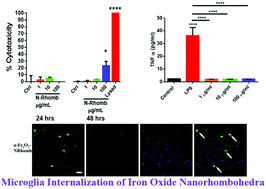Absence of cytotoxicity towards microglia of iron oxide (α-Fe2O3) nanorhombohedra†
Abstract
Understanding the nature of interactions between nanomaterials, such as commercially ubiquitous hematite (α-Fe2O3) nanorhombohedra (N-Rhomb) and biological systems is of critical importance for gaining insight into the practical applicability of nanomaterials. Microglia represent the first line of defense in the central nervous system (CNS) during severe injury or disease such as Parkinson's and Alzheimer's disease as illustrative examples. Hence, to analyze the potential cytotoxic effect of N-Rhomb exposure in the presence of microglia, we have synthesized Rhodamine B (RhB)-labeled α-Fe2O3 N-Rhomb, with lengths of 47 ± 10 nm and widths of 35 ± 8 nm. Internalization of RhB-labeled α-Fe2O3 N-Rhomb by microglia in the mouse brain was observed, and a dose-dependent increase in the cellular iron content as probed by cellular fluorescence was detected in cultured microglia after nanoparticle exposure. The cells maintained clear functional viability, exhibiting little to no cytotoxic effects after 24 and 48 hours at acceptable, physiological concentrations. Importantly, the nanoparticle exposure did not induce microglial cells to produce either tumor necrosis factor alpha (TNFα) or interleukin 1-beta (IL1β), two pro-inflammatory cytokines, nor did exposure stimulate the production of nitrites and reactive oxygen species (ROS), which are common indicators for the onset of inflammation. Finally, we propose that under the conditions of our experiments, i.e. in the presence of RhB labeled-α-Fe2O3 N-Rhomb maintaining concentrations of up to 100 μg mL−1 after 48 hours of incubation, the in vitro and in vivo internalization of RhB-labeled α-Fe2O3 N-Rhomb are likely to be clathrin-dependent, which represents a conventional mechanistic uptake route for most cells. Given the crucial role that microglia play in many neurological disorders, understanding the potential cytotoxic effects of these nanostructures is of fundamental importance if they are to be used in a therapeutic setting.

- This article is part of the themed collection: Alzheimer's Research Month 2016

 Please wait while we load your content...
Please wait while we load your content...